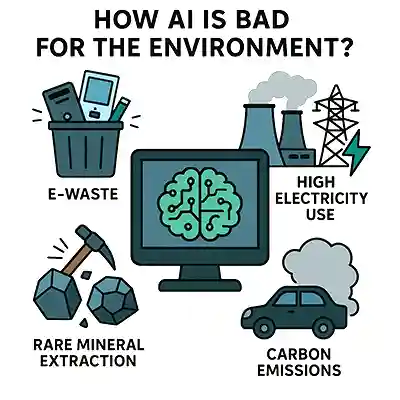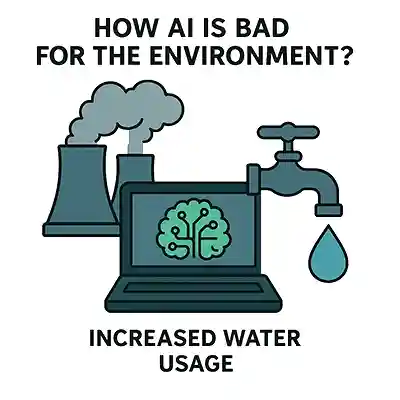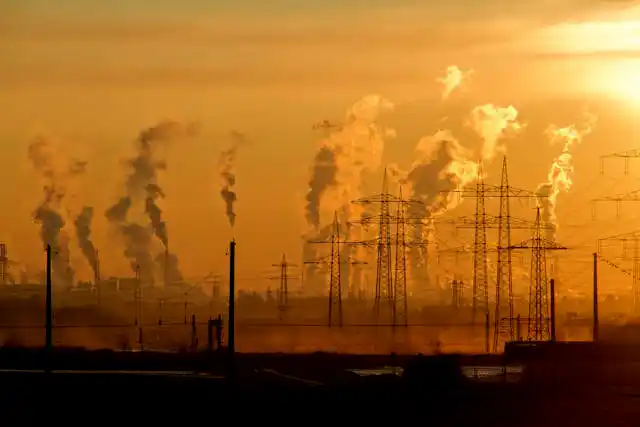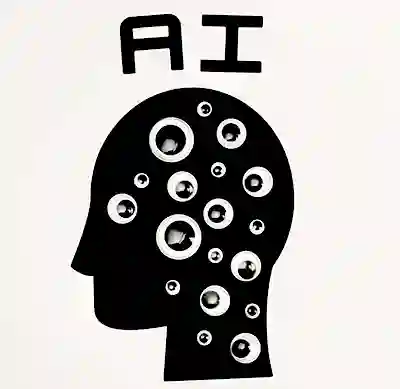- Home
- Tech
- FashionDiscover the latest trends, style tips, and fashion news from around the world. From runway highlights to everyday looks, explore everything you need to stay stylish and on-trend.
- About
- My Account
- Contact us
- Home
- Tech
- FashionDiscover the latest trends, style tips, and fashion news from around the world. From runway highlights to everyday looks, explore everything you need to stay stylish and on-trend.
- About
- My Account
- Contact us
Now Reading: How AI is bad for the environment? Is AI really sucks?
-
01
How AI is bad for the environment? Is AI really sucks?
- Home//
- Tech//
- Fashion//Discover the latest trends, style tips, and fashion news from around the world. From runway highlights to everyday looks, explore everything you need to stay stylish and on-trend.
- About//
- My Account//
- Contact us//

While Artificial Intelligence (AI) has brought blessings to human civilization, its harm to the environment is not to be neglected. We already know that technology products cause adverse effects on the environment because electronic products become electrical waste at the end of their life. Electronic waste is a very toxic matter for the environment. It is extremely harmful to the environment.
With the passage of time, the power of the computer has increased by many orders than before. And using this power, the power of artificial intelligence has increased manifold. Since artificial intelligence is constantly growing, a large number of electronic devices, more high-powered computers, etc., are being developed to increase its power. As a result, the amount of electronic waste has increased more than before.
Apart from this, the development of artificial intelligence has created additional demand on all things, including electricity, water, fossil fuels. Even artificial intelligence is dependent on the important rare elements of nature. These rare elements are very small in nature. There is also the effect of artificial intelligence on global warming, including greenhouse gases, which is really very alarming.
Early forms of AI have been around since around 1950. Artificial intelligence technologies have been greatly developed due to the advancement of computing power in the present time.
So let’s briefly know: what is artificial intelligence? How does artificial intelligence work? How is artificial intelligence harming the environment, etc.?
What is Artificial Intelligence or AI?
Artificial Intelligence basically refers to a set of technologies that can process information. And for this information processing, artificial intelligence has to be provided with a lot of information first. These data are mainly provided so that the artificial intelligence can judge the data and make itself proficient on the subject. Later, artificial intelligence uses this skill to make predictions. Artificial intelligence can predict very accurately and perfectly. Because of this, many future work plans are being relied on the predictions of artificial intelligence.
Artificial intelligence can accurately determine any inconsistencies and similarities between given data.
Also, artificial intelligence can precisely mimic human thinking. As a result, it can react much like humans. As a result, artificial intelligence is being used in many call centers instead of people.
Artificial intelligences consume a lot of electricity:

Because of this huge amount of information—first analyzing the judgment, then mastering itself with this information, and after mastering it, predicting what will happen in the future—all this artificial intelligence has to do in a very short time. Since it has to do many tasks in a short period of time, artificial intelligence uses a lot of computer resources. And due to the use of these additional resources, the computer itself uses a lot of electricity. The amount of electricity used is many times more than a normal computer. A simple example will give some idea about the subject. For example, if we search for something on Google, the amount of electricity consumed is about ten times more in AI-based search than a Google search.
In addition, AI infrastructures consume a large portion of global electricity, which may be responsible for future power shortages.
Again, artificial intelligences such as OpenAI’s GPT-4 require a lot of electricity to provide the necessary energy for training, and such AI models emit carbon dioxide, which is harmful to the environment. Besides, even after the AI models are trained using data, their electricity consumption does not stop. Every time we try to learn something from a model—yes, the models consume electricity. It consumes at least five times and in some cases almost 10 times more power than a normal web search. In addition, AI technology is being used in almost everything from many apps to cellphone cameras, which are using much more energy or power than usual. It is also known that the computing power needed to train advanced AI models is doubling every three and a half months.
In the world where the demand for electricity is still greater than the supply, and the balanced distribution of electricity has not been possible in all parts of the world, this excess amount of electricity consumption by artificial intelligence is a threat to the human race and the environment. The threat to the environment is due to the fact that fossil fuels are used for the production of electricity, which are extracted from nature, but these fossil fuels exist in very limited quantities in nature. Nature is being mined in a destructive way to collect these fossil fuels, which is no less harmful to the environment.
What scientists at the University of California estimated in 2021 about the amount of electrical energy that might be needed to train an AI model like Chat GPT-3 is quite surprising. According to scientists, training an AI model like Chat GPT-3 requires about the same amount of electricity as the total electricity required for a year in about 120 US homes. It is also known that OpenAI’s current GPT-4 model is consuming 12 times more power than its previous models.
Also, some more surprising information can be given. For example, researchers at the University of Manchester, while training some popular AI models, saw that the amount of carbon dioxide produced by the models was almost equal to the amount of carbon emitted by a flight from New York to San Francisco 300 times.
To put it another way, the amount of carbon dioxide that a car emits in its lifetime is about five times less than the amount of carbon dioxide emitted to train an AI model. Things are actually surprising.
The fear surrounding artificial intelligence is that experts believe that the demand for AI-related technologies will continue to grow. The advancement of AI will continue in the coming days and the number of data centers will increase.
More due to artificial intelligence — Generation of e-waste:

One of the great possibilities of artificial intelligence is that it can help us deal with the world’s major environmental emergencies. AI is already being used to map destructive sand mining and emissions of the powerful greenhouse gas methane. Therefore, the development of artificial intelligence is not being stopped. In addition, the driving force of artificial intelligence means that its infrastructure needs to be developed. And the infrastructure includes computers and various computer-related equipment. Again, one of them is GPU or Graphics Processing Unit. A lot of e-waste is generated in the manufacturing and disposal of AI hardware, including GPUs. Cobalt and lithium are also used to make AI hardware. They are first extracted as raw materials from mines. Cobalt and lithium are then extracted and made usable through processing. As a result of all these activities with these elements that are harmful to the environment, there are various damages to biodiversity starting from environmental pollution. In addition, data centers constantly produce hazardous chemicals such as lead, mercury, and cadmium that can run underground and contaminate water. As a result, all these pollutants enter the body of the fish and can enter the human body through that fish. In addition, all these pollutants can directly enter the human body through drinking water, which will lead to dire consequences for people. As a result, it can endanger both human health and the environment. According to experts, only proper e-waste management and recycling can protect humans and the environment from imminent danger.
Fear of Global Warming Due to Artificial Intelligence:

Large-scale data centers are required for artificial intelligence operations and to store the data it provides. As artificial intelligence is growing rapidly, the number of data centers is increasing at the same rate. Growing data centers was not much of a problem unless they used electricity. The main driving force of data centers is electricity. Compared to normal computers, AI-powered computers or devices consume relatively much more electricity. Because AI researches a lot of data in a very short time and predicts the future. So AI computers and their GPUs use a lot of electricity to make predictions by processing a large amount of data in a short time and become extremely hot. As a result, a data center operated by many computers is constantly emitting a lot of heat.
It takes a lot of money to build data centers, and high-quality cooling systems are used to protect all these high-performance computer GPUs and data centers from potential hazards. Among these cooling systems are air cooling and liquid cooling. In air cooling, the temperature is reduced by blowing a lot of air with the help of a fan. On the other hand, a liquid cooling system is used in all the equipment that emits excessive heat. The liquid cooling system works better than the air cooling system in many cases. Where the air cooling system is not sufficient, the liquid cooling system is able to reduce the temperature better. And to run these cooling systems, a large amount of electricity is being used as well as a large amount of water. And due to this huge amount of water consumption, the data centers located in some areas are causing water shortages.
Thus, artificial intelligence-driven components also contribute to increased demand for cooling process water and infrastructure stress. It is known that a quarter of the world’s people lack access to clean water and sanitation. So how reasonable is it to put pressure on water in this situation?
Greenhouse Gas Generation Due to Artificial Intelligence:

Artificial intelligence depends on certain minerals obtained from nature. Also, among its other essential elements are some rare natural elements that are found in very small quantities in nature. The ingredients are not easily found in nature. All these rare elements are mined restlessly in nature. All of these rare earth elements are used in the microchips that power AI.
Firstly, in nature, one after another such violent bursts are disrupting the balance of the environment, and secondly, all these rare elements are made to power complex electronics and AI components. A large amount of electricity is used, most of which is generated by burning fossil fuels. And burning fossil fuels produces a gas called greenhouse gas, which has an effect on increasing the temperature of the planet.
Where the heads of state of the world are meeting one after another to reduce global warming even by one degree, the impact of AI in increasing global warming cannot be neglected in any way.
Impact of Artificial Intelligence (AI) on Natural Ecosystems:
The use of artificial intelligence in the agricultural sector has increased the use of pesticides and fertilizers, which is polluting the soil and water. Due to soil and water pollution, all these pollutants are entering the fruits, vegetables, and fish in the water, which later enters our body through food, causing complications.
The application of artificial intelligence in e-commerce has made the delivery process much faster than before. For example, in many countries, it is possible to make very fast deliveries through drones. This is convenient on one hand. On the other hand, the large amount of e-waste created due to AI is harmful to the environment.
Again, if AI models are trained incorrectly, they will cause bad situations instead of good ones for the environment. For example, if they are taught in such a way that they think without considering the damage to the environment, in such a way that businessmen can achieve more financial profit, then the artificial intelligences can prioritize financial profit for the businessmen despite the damage to the environment, which will bring environmental harm instead of benefit.
Addressing environmental damage caused by artificial intelligence:
There is no end to the speculation surrounding artificial intelligence. Experts fear that AI may have unexpected consequences in the days ahead. For this reason, both the European Union and the United States have enacted strict laws to prevent AI-related environmental damage.
Artificial intelligence is one of the many things that are being developed in this time of technology. If it is used properly and in a controlled manner, it is expected to bring many benefits to mankind.
Shagar
Will this really bring good to humanity? What do you think? Don’t forget to give your opinion.
If you like the post, don’t forget to upvote and share it.
Goodbye today see you in next post.
Related Posts
Stay Informed With the Latest & Most Important News
Previous Post
Next Post
Enter your email and click subscribe to not miss the latest and important news.
Recent Posts
- 21 Best Labor Day T-Shirt Deals on Amazon (Reviewed)
- Will AI Replace Accountants? No, AI Won’t Replace Accountants Yet. But Why? Let’s Get Some Clear Explanations.
- Is AI Bad for Education? Pros and Cons of AI in Education
- Will AI replace doctors? Is artificial intelligence a threat to doctors? Let’s find out.
- How AI is bad for the environment? Is AI really sucks?


















